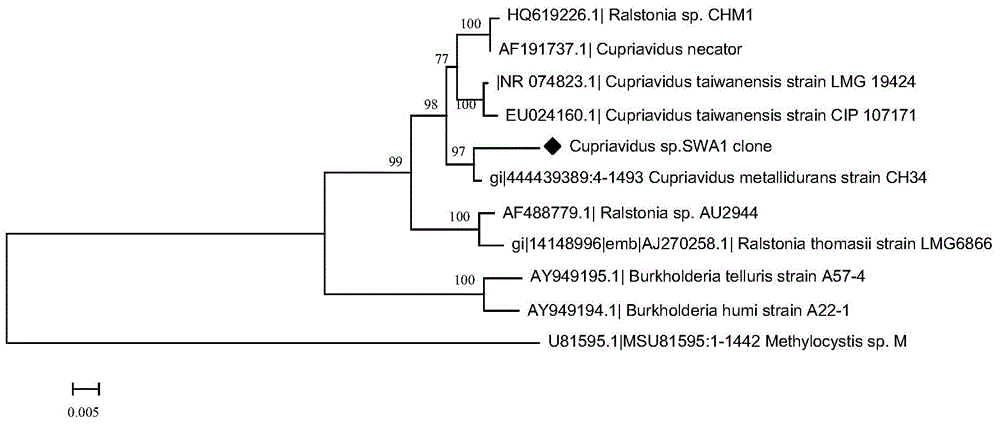Cupriavidus sp.SWA1 capable of degrading chlorinated olefin and application thereof
A technology of chlorinated alkene and copper-loving bacteria, applied in the field of copper-loving bacteria, can solve problems such as limiting the application of chlorinated hydrocarbons
- Summary
- Abstract
- Description
- Claims
- Application Information
AI Technical Summary
Problems solved by technology
Method used
Image
Examples
Embodiment 1
[0034] Example 1 Purification and Identification of Cupriavidus sp.SWA1
[0035] The bacterium is a gram-negative bacterium, the colony diameter is about 1mm, the color is white and translucent, protruding, the edges are neat, and the surface is shiny; Gram staining is negative. The sequencing of the 16S rDNA of Cupriavidus sp.SWA1 was entrusted to Dalian Bao Biological Co., Ltd. The length of the base determination was 1497bp (SEQ ID NO: 1). The base sequence was compared with the GenBank nucleic acid sequence database and found to be similar to that of the genus Cupriavidus The strain Cupriavidus metallidurans strain CH34 of Cupriavidus sp. has 98% homology. Phylogenetic tree from Cupriavidus sp.SWA1 (see figure 1) shows that Cupriavidus sp. is closely related to Ralstonia sp., and the previous studies classified the two into one category. Later, because of the emergence of new functions of Ralstonia sp., the classification level changed, and it was changed from Cupriavidus...
Embodiment 2
[0036] Example 2 Degradation Effect of Cupriavidus sp.SWA1 on Different Chlorinated Hydrocarbons
[0037] Prepare trichlorethylene, dichlorethylene, and vinyl chloride solutions with a concentration of 2g / L respectively, and add 100μl each to a 100ml serum bottle containing 20ml NMS medium, steam the above-mentioned NMS medium at 121°C Sterilize, after cooling down, add 1ml of Copper greedy bacterial solution (OD 600nm 0.7), cover the rubber stopper and shake well, put it into a shaker and set it at 30°C and 160 rpm to cultivate for 40h, then measure the content of chlorinated olefins by gas chromatography headspace to determine the degradation effect of chlorinated olefins , to determine the OD of the bacterial solution 600nm The value determines the growth of the bacteria. It can be seen from Table 1 that Cupriavidus sp.SWA1 can degrade chlorinated olefins very well, and the degradation effect of trichlorethylene is the best, reaching 73.2%.
[0038] Table 1 Degradation e...
Embodiment 3
[0040] Example 3 Degradation Effect of Cupriavidus sp.SWA1 on Different Concentrations of Trichlorethylene
[0041] Prepare a trichlorethylene solution with a concentration of 2g / L and add it to a 100ml serum bottle containing 20ml of NMS medium. The concentrations of trichlorethylene are 1.65mg / L, 2.73mg / L, 5.40mg / L, and 7.99mg / L. and 10.1mg / L. Add 1ml of Cubacterium greedy bacteria solution (OD 600nm 0.7), cover the rubber stopper and shake well, put it into a shaker and set it at 30°C and 160 rpm to incubate for 80h, then use gas chromatography to measure the content of chlorinated olefins, and determine the degradation effect of chlorinated olefins. The degradation effect of different concentrations of trichlorethylene see figure 2 . When the concentration of trichlorethylene is less than 5.40mg / L, the degradation effect is good, and the degradation rate of trichlorethylene reaches more than 95%. When the concentration of trichlorethylene was higher than 5.40mg / L, the...
PUM
 Login to View More
Login to View More Abstract
Description
Claims
Application Information
 Login to View More
Login to View More - R&D
- Intellectual Property
- Life Sciences
- Materials
- Tech Scout
- Unparalleled Data Quality
- Higher Quality Content
- 60% Fewer Hallucinations
Browse by: Latest US Patents, China's latest patents, Technical Efficacy Thesaurus, Application Domain, Technology Topic, Popular Technical Reports.
© 2025 PatSnap. All rights reserved.Legal|Privacy policy|Modern Slavery Act Transparency Statement|Sitemap|About US| Contact US: help@patsnap.com



